Crafting Delicious Whole Foods Coleslaw Dressing
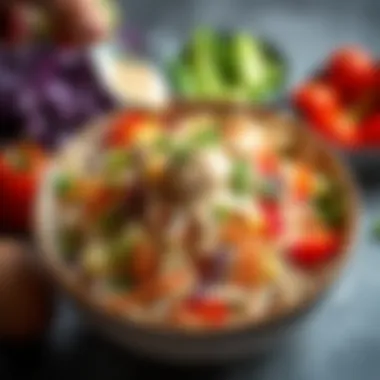
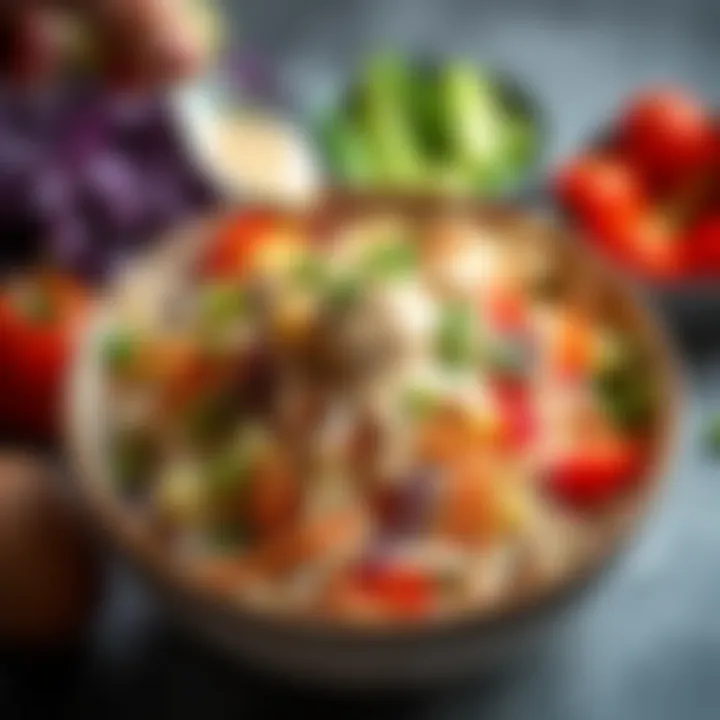
Intro
Whole foods coleslaw dressing, while seemingly straightforward, holds a treasure trove of flavors and health benefits that many overlook. As we embark on this culinary journey, it’s essential to appreciate not only the taste but also the myriad of ways this dressing can be tailored to individual palates. Coleslaw itself is a refreshing dish, often served as a side, but it transforms into a star player when paired with a thoughtfully crafted dressing.
The significance of selecting whole food ingredients cannot be understated. By utilizing fresh and unprocessed items, one elevates the dish's nutritional profile, making each bite not just delicious but also nourishing. Diving into the essence of coleslaw dressing means recognizing its ability to accommodate various dietary preferences—from vegan to gluten-free, and everything in between.
This article will cover key ingredient choices, preparation methods, and health benefits, guiding you to create the perfect dressing. Through traditional recipes and innovative twists, readers will gain insights to craft their unique blends, enriching the individual drop of flavor in their coleslaw.
Let’s start peeling back the layers and delve into a comprehensive exploration of whole foods coleslaw dressing.
Prologue to Whole Foods Coleslaw Dressing
When it comes to crafting the perfect coleslaw, the dressing plays a pivotal role in defining the dish’s character and flavor profile. Whole Foods Coleslaw Dressing not only stands out for its fresh ingredients but also embodies a connection to health and holistic eating that resonates with many home cooks and culinary enthusiasts. In this exploration, we delve into the various elements that make Whole Foods Coleslaw Dressing significant, highlighting its benefits and considerations.
Using whole foods in coleslaw dressing means focusing on natural, minimally processed ingredients. It’s about getting back to the roots – quite literally. This type of dressing avoids artificial flavors and preservatives, allowing the inherent flavors of the vegetables to shine. The first step in appreciating this dressing is understanding that it’s not just about taste; it’s about nutrition, too.
Whole foods are packed with vitamins, minerals, and fiber. By incorporating them into your coleslaw dressing, you’re not only enhancing the flavor but also boosting the overall health benefit of your meal. For instance, ingredients like apple cider vinegar and fresh herbs contribute not just to taste but also to digestive health.
Moreover, opting for a homemade dressing made from whole foods allows for customization. Want a spicier kick? Toss in some horseradish. Prefer a sweeter note? Honey or maple syrup could be your go-to. With this level of control, cooks can adjust their dressings to accommodate various dietary preferences and restrictions.
Another layer to consider is the cultural significance attached to coleslaw in various cuisines. Each culture puts its twist on this simple dish. A whole foods approach embraces these variations, encouraging chefs to experiment and share. Think of creamy, rich dressings in Southern cooking, or tangy vinaigrettes found in Eastern European cuisines. An acceptance of diversity in food preparation becomes part of the creative process in making coleslaw dressing.
The essence of Whole Foods Coleslaw Dressing lies in its ability to transform not only the presentation of a dish but also its nutritional value and cultural relevance.
In sum, the approach to Whole Foods Coleslaw Dressing is multifaceted. With an emphasis on freshness, health, and creativity, it serves as a powerful tool in any cook's arsenal. Whether you’re crafting a classic recipe or venturing into innovative combinations, understanding the importance of these dressings lays the groundwork for delightful culinary experiences.
Understanding the Basics of Coleslaw
Coleslaw is not just a simple dish; it embodies a rich tradition that varies from one place to another. Understanding its basics can provide insight into the culinary choices that shape our meals, particularly when it comes to Whole Foods coleslaw dressing. It’s essential to appreciate the context and dimensions of coleslaw as a staple, especially since this dressing plays a crucial role in enhancing its flavors.
Historical Context of Coleslaw
Coleslaw’s history dates way back, possibly even to ancient Rome, where a salad made from cabbage and eggs dressed in vinegar was first noted. Over time, this dish traveled and transformed across regions. By the 18th century in America, coleslaw began to resemble the creamy dishes we’d recognize today. While the ingredients have evolved, the underlying concept of combining fresh vegetables with a variety of dressings has remained steady. This historical journey illustrates the dish's adaptability and appeal across cultures.
A noteworthy point is that coleslaw was once primarily a way to preserve vegetables, extending their shelf-life before refrigeration became commonplace. To this day, its use as a side dish at barbecues and gatherings is a nod to this past, marrying practicality with flavor.
Typical Ingredients in Traditional Coleslaw
Traditional coleslaw generally relies on a few simple components:
- Cabbage: The base ingredient that adds crunch and structure. Green cabbage is commonly used, but varieties such as red or Savoy also provide unique flavors and visual appeal.
- Carrots: Grated or shredded, they bring a hint of sweetness to the mix.
- Dressing: This can range from creamy mayonnaise to a zesty vinaigrette, each transforming the coleslaw into something distinct.
While it’s easy to think of coleslaw as merely cabbage and dressing, the way these ingredients are treated can make a world of difference. The freshness of the vegetables, the quality of the dressing, and even the way flavors meld can turn an ordinary side into an extraordinary mainstay.
Cultural Variations of Coleslaw
Coleslaw is a canvas, painted with flavors from around the globe, resulting in intriguing locals spins on this hearty dish. For instance:
- In Germany, a similar dish called Krautsalat features simple vinegar and oil dressings, emphasizing a tangy element that complements heavier meats.
- Asian coleslaw often incorporates soy sauce, sesame oil, and ginger, reflecting the vibrant flavors found in many Asian side dishes.
- Moving over to the Southern USA, you’ll encounter versions with hardboiled eggs or a sweet dressing that could include a splash of sugar or even fruit.
Each regional variant of coleslaw retains the essence of the original while indulging in local taste preferences, showcasing how versatile and adaptable this dish truly is. Understanding these cultural differences not only enriches our appreciation of coleslaw but also fuels creativity in crafting new Whole Foods-inspired dressings.
Defining Whole Foods in Cooking
Whole foods have become a topic of significant interest in recent years, not just among chefs but also for home cooks and health enthusiasts alike. In this article, we aim to shed light on the importance of whole foods in cooking, particularly when it comes to crafting coleslaw dressing that is both nutritious and flavorful. Cooking with whole foods means choosing minimally processed ingredients — those that are close to their natural state. The relevance of this philosophy in preparing coleslaw dressing cannot be overstated, as it ensures that each component retains its nutritional integrity and contributes positively to overall health.
The Philosophy of Whole Foods
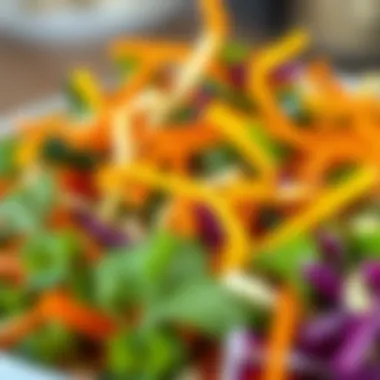
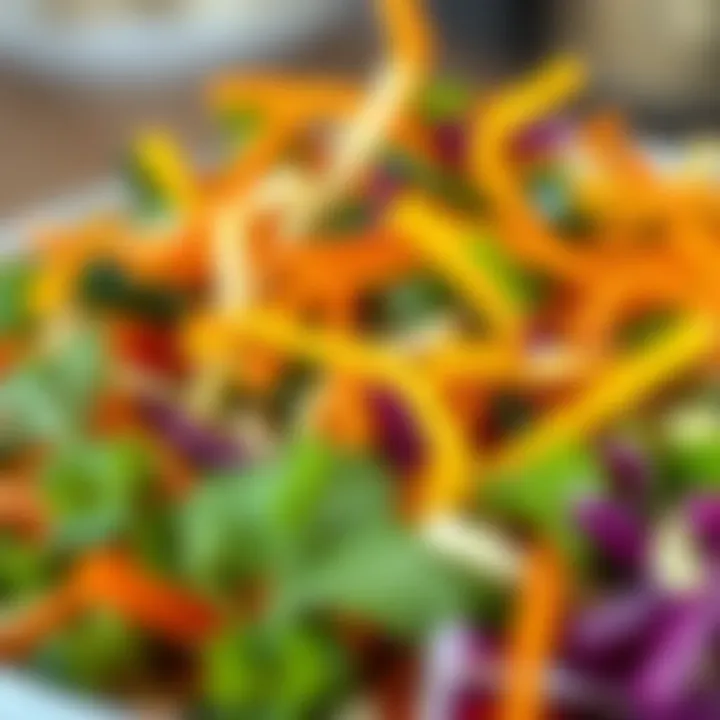
The essence of cooking with whole foods lies in its fundamental philosophy — to embrace ingredients that are wholesome and nourishing. This approach is about more than just following a trend; it reflects an understanding that many processed foods often lose their beneficial properties during manufacturing.
When you prepare coleslaw dressing, utilizing whole foods could mean opting for fresh vegetables, unprocessed oils, and natural sweeteners instead of their heavily processed counterparts. It’s akin to taking a stroll through a local farmer’s market versus hitting a large grocery store aisle filled with ready-made items.
Key tenets of this philosophy include:
- Simplicity: Whole foods often come with fewer ingredients, allowing their natural flavors to shine.
- Seasonality: Emphasizing seasonal produce taps into fresh flavors and nutrients that are at their peak.
- Sustainability: Supporting local farms and reducing processed food consumption aligns with a broader commitment to environmental health.
This commitment to natural Ingredients means that the dressing you create for your coleslaw is not just a mere condiment—it's a genuine reflection of your cooking philosophy.
Nutritional Benefits of Whole Foods
The advantages of integrating whole foods into your cooking extend beyond taste; they are a treasure trove of nutritional benefits. Let’s break down the core nutrients commonly found in whole foods used for coleslaw dressing:
- Vitamins: Fresh vegetables like carrots and cabbage are rich in vitamins A and C, promoting eye health and immune function.
- Fiber: Whole ingredients help maintain digestive health and contribute to a feeling of fullness, which is often missing in processed alternatives.
- Healthy Fats: Using oils such as extra virgin olive oil, in light of whole foods principles, supports heart health and provides essential fatty acids.
- Antioxidants: Many whole food ingredients are natural sources of antioxidants, aiding in fighting free radicals and reducing inflammation.
Incorporating these ingredients not only enhances the nutritional profile of your coleslaw dressing but also contributes to a balanced diet. Cooking with whole foods fosters a deeper connection to what you consume, helping you make informed dietary choices.
Whole foods serve not only as a basis for flavors but also as vital nutritional pillars for your body. This creates a robust palette for your coleslaw dressing, allowing you to craft delicious, healthy options that cater to various dietary needs and preferences.
Overall, crafting your coleslaw dressing with whole foods is a marriage of taste and health—each ingredient tells a story of nourishment, connection, and culinary tradition.
Crafting Whole Foods Coleslaw Dressing
Crafting a remarkable whole foods coleslaw dressing is not merely about tossing together ingredients. It’s an art that speaks to the heart of culinary practices and healthy eating. When you craft a dressing with whole foods, you’re embracing not just flavor, but also nutrition and freshness. The right dressing acts as a bridge that connects all your ingredients, enhancing textures and flavors, making your coleslaw a delight for the senses.
Essential Ingredients for a Base Dressing
When setting out to create a base for your coleslaw dressing, the core elements should be thoughtfully chosen. Here’s what you might consider:
- Oil: Opt for high-quality oils such as extra virgin olive oil or avocado oil. These options not only offer health benefits but add depth to the flavor.
- Vinegar: Apple cider vinegar or white wine vinegar can bring that necessary kick to the dressing. These acids can brighten flavors and help in the overall balance.
- Sweeteners: A touch of sweetness often rounds out the tanginess. Think honey, maple syrup, or even agave nectar. A small amount works wonders to balance the flavors.
- Seasoning: Don’t forget salt and pepper. They amplify flavors in a subtle yet significant way. You can also consider spices like garlic powder or onion powder for added depth.
Mix these ingredients well until they emulsify. The base dressing will serve as the canvas for your entire coleslaw masterpiece.
Flavor Enhancements for Diverse Palates
Once you’ve established a base, it’s time to add character. The beauty of whole foods coleslaw dressing lies in its versatility. Here are some ideas:
- Herbs: Fresh herbs like parsley, dill, or cilantro can transform your dressing from standard to spectacular. They provide freshness that can elevate the entire dish.
- Fruits: Consider folding in some pureed fruits—mango or pineapple can add sweetness and a tropical flair.
- Spices: A pinch of cumin or smoked paprika can provide warmth and complexity. If you’re daring, a dash of chili powder or cayenne can add heat.
- Seeds and Nuts: Toasted sesame seeds or chopped nuts can add a pleasing crunch, along with unique flavors that differentiate your dressing.
With these enhancements, you're crafting a dressing capable of appealing to a variety of tastes, ensuring that each bite of coleslaw reflects a tapestry of flavors.
The Role of Acidity in Dressing Balance
Acidity is the unsung hero in the realm of dressings. When it comes to coleslaw, understanding the balance of acidity is paramount. It tends to brighten the overall flavor profile, cutting through richness, especially in creamy dressings.
- Balancing Act: A well-balanced dressing should have a delightful tension between acidity and sweetness. If you find your dressing too tangy, simply add a little more sweetener; conversely, if it’s too sweet, a splash more vinegar can create the necessary contrast.
- Variety in Acid: You might even experiment with different types of vinegar or citrus juice. Lime juice can offer a zesty note that’s refreshing, while balsamic vinegar provides a sweetness that is both robust and enjoyable.
- Critical testing: Always taste as you go. What works for one palate might not work for another, so adjusting flavors is key to achieving harmony in your dressing.
Understanding the role of acidity not only enhances your coleslaw but guarantees that your creation will be memorable. The right blend of flavors and textures will make your dressing the talk of the table.
"A good dressing is like a good friend; it complements you, supports you, and enhances your beauty."
By delving into the art of dressing crafting, you’re setting the stage for a coleslaw that is rich in flavor and deeply satisfying. Pay attention to each element, and you will find that the journey of crafting your whole foods coleslaw dressing is truly rewarding.
Alternative Dressing Options
When it comes to coleslaw, the dressing plays a pivotal role. It's more than just a flavor enhancer; it determines the overall character and appeal of the entire dish. In today’s culinary landscape, where health consciousness and dietary restrictions are on the rise, exploring alternative dressing options has become imperative. This section will address the significance of diverse dressing options, focusing on vegan, dairy-free, low-calorie, and health-conscious alternatives. By considering these variations, consumers can enjoy coleslaw while catering to their dietary needs and preferences.
Vegan and Dairy-Free Dressings
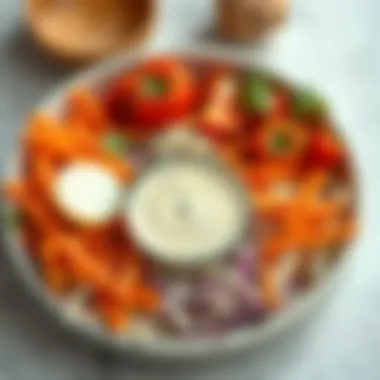

For those embracing a plant-based lifestyle or with dairy allergies, vegan and dairy-free dressings offer a treasure trove of flavor without compromising health. Traditional mayonnaise typically used in coleslaw is rich and creamy, but it often contains eggs and dairy. Replacing it with alternatives like silken tofu provides a smooth consistency. Other options include:
- Avocado-based dressings: Known for their healthy fats, they lend a creamy texture while adding a distinct flavor.
- Nut-based dressings: Think cashew cream or almond milk-based dressings, which can substitute for creaminess without the dairy.
- Store-bought alternatives: Brands like Follow Your Heart or Just Mayo have hit the market with vegan mayo options.
Not only do these alternatives cater to vegan diets, but they also allow everyone to indulge in coleslaw without the worry of dairy-related discomforts. This flexibility has paved the way for new and exciting flavor combinations, encouraging culinary experimentation.
Low-Calorie and Health-Conscious Alternatives
In a world where health headlines reign supreme, low-calorie options in coleslaw dressings are gaining ground. Many individuals are keeping an eye on their waistlines without forgoing flavor. By creating lighter dressings, one can enjoy coleslaw guilt-free. Key elements include:
- Greek yogurt: This ingredient is a fantastic substitute for mayonnaise. It maintains creaminess but with a fraction of the calories.
- Vinegar-based dressings: Balsamic or apple cider vinegar can reduce calorie content while enhancing flavor significantly. A splash of lemon juice can also brighten up the dish while keeping it light.
- Mustard blends: Combining mustard with water and spices delivers a zesty kick without adding much to the calorie count.
These alternatives are more than just a choice; they’re a lifestyle shift for many. Emphasizing fresh vegetables and robust flavors enables the creation of a coleslaw that represents both health and taste.
"Opting for lighter dressings doesn’t mean cutting corners on flavor; it’s about extracting the essence of the ingredients themselves."
In summary, diversifying dressing options is essential in today’s culinary choices. By exploring vegan, dairy-free, low-calorie, and healthy alternatives, one can create a coleslaw that not only satisfies but also aligns with diverse dietary preferences. This exploration opens the door to innovative recipes that resonate with a broader audience.
Preparing and Storing Your Dressing
When it comes to crafting a delightful whole foods coleslaw dressing, how you prepare and store it can make all the difference. Not only is the preparation method crucial for ensuring flavors meld beautifully, but proper storage safeguards the freshness and potency of the ingredients. After all, the essence of a good dressing lies in its ability to enhance the coleslaw, and paying attention to these elements will elevate any dish you plan to serve.
Methods of Preparation
To kick things off, understanding different methods of preparation is key. In a world where shortcuts are often tempting, taking the time to prepare your dressing with intention will yield better results. Here are several methods worth considering:
- Whisking by Hand: This is a classic method. Combining ingredients in a bowl and whisking creates an emulsion. It's simple and effective, allowing for better control of texture.
- Blending: Using a blender or food processor provides a creamy consistency, particularly beneficial when adding nuts or seeds for extra flavor. Just toss your ingredients in and let the machine work its magic.
- Mason Jar Shaking: A personal favorite for many, putting all ingredients into a mason jar and shaking vigorously blends flavors well. This method is not only effective but also great for storage.
Using any of these methods can significantly affect the texture and flavor of your dressing. The right choice depends on your preferences and the desired outcome.
Storage Tips for Freshness
After you've prepared your dressing, the next important step is how to store it. Dressing can begin to lose its freshness rapidly if not stored correctly. Here are some practical tips:
- Use Air-tight Containers: Always transfer your dressing to an air-tight container. This prevents exposure to air, helping to maintain its freshness for a longer time.
- Refrigeration is Key: As a rule of thumb, most homemade dressings should be stored in the refrigerator. This keeps the ingredients cool and reduces the risk of spoilage.
- Labeling: Don’t forget to label your container with the date you made it. Dressings can last anywhere from a few days to a week, depending on the ingredients. This simple step can save you from crusty, questionable dressing.
- Separation: If your dressing separates (which can happen), give it a good shake before using it again. This is normal and indicates that the dressing is catching some air.
- Check for Changes: Always use your senses before using stale dressing. If it smells off or the color appears strange, it's better to toss it than to take any chances.
Freshness in a dressing is like a breath of fresh air in a dish; it lifts everything up and makes it shine.
In sum, taking the time to prepare your whole foods coleslaw dressing properly and storing it with care will not only enhance your culinary experience but also ensure that your coleslaw maintains its taste integrity. By following these preparation methods and storage tips, you can enjoy your dressing at its best, ready to elevate your meals.
Pairing Your Coleslaw Dressing
Pairing your coleslaw dressing with the right ingredients is pivotal in transforming a simple dish into a delightful culinary experience. The dressing sets the stage for flavors—hearty, tangy, or even sweet—that define a coleslaw. Understanding how to harmonize these essentials can elevate your meal and cater to an array of taste buds. When you think about coleslaw, it’s usually more than just a side; it's a celebration of textures and flavors that complement one another. Here, we break down the importance of certain pairings, spotlighting both traditional sides and surprising combinations that add a unique flair to your coleslaw.
Complementary Ingredients in Coleslaw
Choosing the right complementary ingredients for your coleslaw dressing makes a world of difference. Let's consider some key components:
- Cabbage Varieties: While green cabbage is the standard, using red cabbage can add a splash of color and crunch. Moreover, savoy cabbage, with its crinkled leaves, brings a softer texture that pairs nicely with vinaigrettes.
- Root Vegetables: Carrots are common, but you might also experiment with turnips or radishes. They offer extra crunch and a peppery note that plays beautifully with creamy dressings.
- Herbs and Spices: Fresh dill or cilantro can rejuvenate your coleslaw. Just a sprinkle can add brightness, while spices like caraway seeds can provide an unexpected twist—like jazz music in a classical orchestra.
- Fruits: Sweetness balances out acidity. Adding diced apples or pineapple can create layers of flavor, making each bite a new adventure.
- Nuts and Seeds: Chopped walnuts or sunflower seeds give a delightful crunch and nutritional boost, as well as a rich flavor that harmonizes with a creamy dressing.
By experimenting with these ingredients, you can craft a coleslaw that doesn’t just sit on the plate but interacts with the entire meal.
Serving Suggestions
Once you've tailored your coleslaw dressing to your liking, the next big decision is how to serve it. Your serving presentation can enhance the dish’s appeal and accessibility. Consider the following approaches:
- Traditional Side Dish: Serve your coleslaw in a vibrant bowl next to grilled meats or fish. Traditional BBQ dishes offer a great backdrop where the freshness of coleslaw plays a vital role.
- Tacos or Wraps: Use coleslaw as a crunchy topping for tacos. The coolness cuts through the heat of spicy meats, resulting in a well-rounded dish.
- Layered Salads: For a picnic or potluck, consider creating a layered salad. Place coleslaw in a jar with other colorful veggies, a sprinkle of dressing on each layer, and shake before serving.
- Stuffed Sandwiches: A hearty sandwich filled with coleslaw can delight your palate. Think about a pulled pork or veggie sandwich, topped with a generous dollop of your dressing-filled coleslaw.
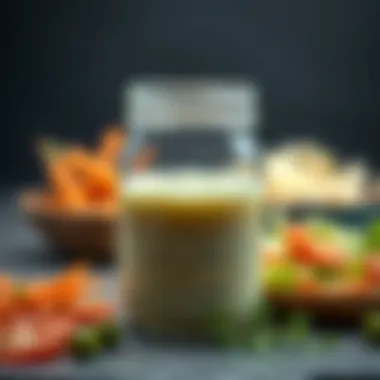
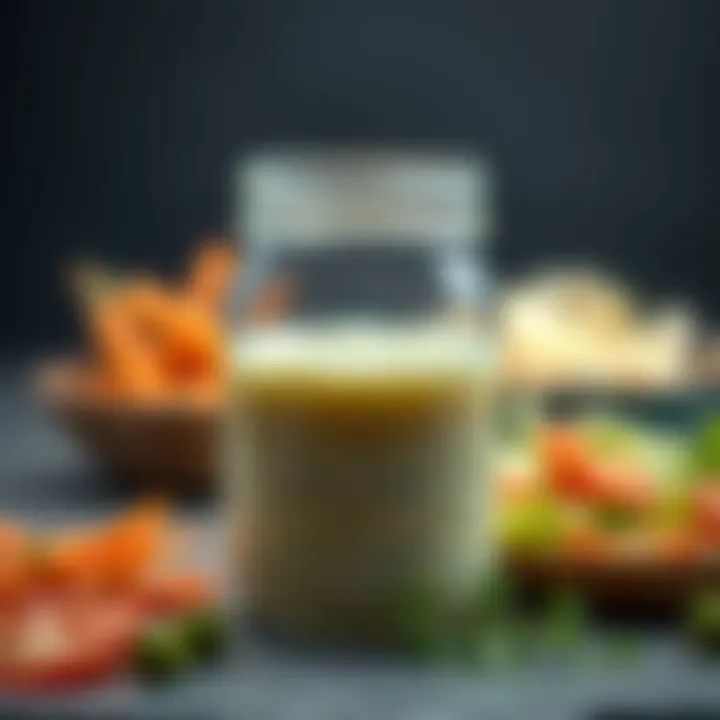
In summary, pairing your coleslaw dressing with thoughtful ingredients not only enhances flavor but acts as a versatile accompaniment. It's like dressing up for a party; every layer contributes to the overall impression. By understanding your choices and experimenting with different ingredients and serving methods, your coleslaw dressing can truly shine in any culinary context.
Nutritional Aspect of Whole Foods Coleslaw Dressing
Understanding the nutritional aspects of whole foods coleslaw dressing is crucial for anyone interested in maintaining a healthy lifestyle. This dressing, while serving as a glorious addition to coleslaw, offers much more than flavor—it holds the potential to enhance the nutritional profile of your meal. Whole foods coleslaw dressing is often crafted from fresh ingredients, which means it's packed with vitamins, minerals, and healthy fats that contribute positively to your overall health. In this section, we'll explore the key nutrients present in traditional ingredients and how they can impact dietary choices.
Key Nutrients in Common Ingredients
When you whip up a batch of whole foods coleslaw dressing, you're likely using some staple ingredients, such as cabbage, carrots, and various oils. Each of these components comes with its unique set of nutrients:
- Cabbage: Rich in vitamin K, which is essential for bone health,
- Carrots: Loaded with beta carotene, a precursor to vitamin A that supports eye health,
- Olive Oil: Contains heart-healthy monounsaturated fats and antioxidants,
- Apple Cider Vinegar: Offers potential benefits for blood sugar control and digestion.
By combining these ingredients in your dressing, you're not just enhancing flavor; you're providing your body with vital nutrients that can support a myriad of bodily functions.
"Eating whole foods is not just a trend—it’s a lifestyle that nourishes the body and soul."
Impact on Dietary Choices
Whole foods coleslaw dressing serves as a multifaceted contributor to one's dietary choices. By opting for a dressing made of whole ingredients, you're often forgoing processed alternatives that contain unhealthy additives and preservatives. The consumption of whole foods is linked to numerous health benefits, including:
- Weight Management: A diet rich in nutrients can help maintain a healthy weight.
- Improved Digestion: Many whole ingredients are high in fiber, which aids digestion.
- Reduced Risk of Chronic Diseases: By eating fresh ingredients, one can lower the risk of conditions such as heart disease and diabetes.
Moreover, these dressings can cater to various dietary habits—from vegan to gluten-free—making them versatile options for many consumers. Embracing the nutritional qualities of whole foods coleslaw dressing encourages informed dietary choices that promote long-term wellness. By understanding and appreciating the nutritional aspect, food lovers can enhance not just their dishes but their health as well.
Innovative Trends in Coleslaw Dressings
Coleslaw has come a long way, evolving from its humble origins to a dish that can be reinvented in numerous ways. The innovative trends surrounding coleslaw dressings reflect a growing interest in culinary exploration, health consciousness, and a desire for flavor diversity. By examining these trends, we not only enhance our cooking repertoire but also align with contemporary dietary preferences, promoting the use of wholesome ingredients.
Global Influences on Coleslaw Preparation
The world is full of flavors, and each region brings its own twist to coleslaw dressing. Traditional American coleslaw, for instance, offers a creamy base with mayonnaise, cabbage, and carrots. But outside the United States, you can find entirely different interpretations.
From Asia, for example, you might encounter a Vietnamese coleslaw that combines shredded cabbage with a zingy fish sauce vinaigrette, topped with crushed peanuts and fresh herbs. The crunch and fresh flavors make it a delightful contrast to rich meats, resembling a salad that's bright and zesty.
In Mexico, coleslaw can take on a spicy persona with the addition of jalapeños and cilantro, dressed with lime juice, making it an excellent accompaniment for tacos or grilled dishes. Such global influences enrich coleslaw, showcasing how simple ingredients can be transformed to embody unique cultural identities.
"Food is not just a source of sustenance; it is a canvas of our culture and creativity."
Fusion Recipes Worth Exploring
Reflecting on innovative trends, fusion recipes have started to characterize modern coleslaw dressings. These recipes blend different culinary traditions, crafting one-of-a-kind concoctions that excite the palate. Here are a few popular fusion ideas:
- Thai-Inspired Coleslaw: Incorporates romaine lettuce, shredded carrots, and a dressing made with peanut butter, soy sauce, and lime juice. The flavors unite to create a dish that can very well substitute a classic meal with something exciting.
- Mediterranean Twist: This version might include olives, feta cheese, and a dressing based on olive oil and red wine vinegar, introducing a savory depth to the typical coleslaw mix.
- Kimchi Coleslaw: Merging Korean kimchi with shredded cabbage introduces a spicy and tangy flavor profile, offering a vibrant addition to any BBQ or picnic.
These fusion recipes not only cater to adventurous eaters but also embrace health benefits. By using a variety of fresh vegetables and low-fat dressings, one can create a coleslaw that’s both nutritious and full of flavor.
As food lovers continue to seek unique culinary experiences, innovative trends in coleslaw dressings will undoubtedly continue to grow, pushing the boundaries of flavors and traditions.
End
The exploration of whole foods coleslaw dressing is not merely an exercise in culinary artistry, but rather a significant aspect of dietary awareness and preference. Understandably, dressing can often make or break a dish, and when it comes to coleslaw, it’s the heart that offers both flavor and depth. This article has navigated through the basics, innovations, and diversities that exist within the realm of coleslaw dressings, revealing a tapestry woven with tradition and modern influences.
Emphasizing whole foods is crucial, as it aligns with contemporary health trends seeking to maximize nutritional value. By choosing fresh, natural ingredients, we ensure that the dressing is not just a complement, but a vital part of a wholesome meal. The body of this article shines a light on key aspects:
- Ingredient Selection: Understanding what goes into your dressing directly impacts health. Whole foods provide essential nutrients often stripped from processed ingredients.
- Preparation Techniques: The way coleslaw dressing is made can enhance or diminish its beneficial properties. Freshly prepared dressings tend to retain more nutrients.
- Cultural Relevance: By examining global influences, we realize that coleslaw is not just a staple in some culture. It’s adaptable, inviting creativity and personalization in each kitchen.
Moreover, keeping abreast of emerging trends is essential for those who wish to keep their culinary repertoire fresh and exciting. The fusion of flavors from various cuisines introduces unique twists that can surprise and delight even the most seasoned food lovers. As this article underscores, crafting an exceptional coleslaw dressing involves a blend of careful ingredient choice, an understanding of palates, and innovative culinary techniques that cater to a variety of diets and preferences.
In sum, as we conclude this exploration, we encourage you to experiment and adapt your own versions of coleslaw dressing. Embrace the philosophy of whole foods, allowing your creativity to flow. After all, the beauty of cooking lies in its ability to reflect personal tastes and cultural backgrounds. Let each flame of creativity ignite delicious dishes on your table, making coleslaw dressing not just a condiment, but a celebration of flavor and nutrition.
"Cooking is about connecting with one another, and whole foods coleslaw dressing connects us through flavor, health, and tradition."
For more information about coleslaw and its variations, consider visiting:















